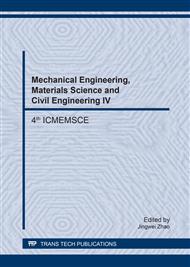[1]
G.F. Mi, X.Y. Liu, K.F. Wang, J.T. Niu, Numerical simulation of low pressure die-casting aluminum wheel, , China Foundry, Vol. 48, No. 1, pp.48-52 (2009).
Google Scholar
[2]
P.H. Huang, B.T. Wang, Y.T. Chen, An effective method for separating casting components from the runner system using vibration-induced fatigue damage, Int J Adv Manuf Technol, Vol. 74, pp.1275-1282 (2014) doi: 10. 1007/s00170-014-6077-z.
DOI: 10.1007/s00170-014-6077-z
Google Scholar
[3]
P.H. Huang, S.C. Hung, C.J. Lin, Optimal pouring system design for investment casting of cladding thin-plate heater using metallic mold flow analyses, Applied Mechanics and Materials, Vol. 627, pp.46-49 (2014).
DOI: 10.4028/www.scientific.net/amm.627.46
Google Scholar
[4]
Z.J. Wang, Y. Zhao, H.W. Song, X.D. Xu, R.J. You, Numerical simulation of low pressure casting large size aluminum alloy wheel and its process optimization, Computer Application Technology, Vol. 34, No. 3, (2014) doi: 1001-2249(2014)0. -0256-04.
Google Scholar
[5]
P.H. Huang, M.J. Guo, A study on the investment casting of 17-4PH stainless steel helical impeller of centrifugal pump, Materials Research Innovations, Vol. 19, Issue. sup9, pp.77-81 (2015) doi: 10. 1179/1432891715Z. 0000000001924.
DOI: 10.1179/1432891715z.0000000001924
Google Scholar
[6]
L.C. Kong, Simulation on Low Perssure Casting Process of Aluminum Alloy, , Foundry Technology, Vol 36, No. 6, (2015) doi: 10. 16410/j. issn1000-8365. 2015. 06. 055.
Google Scholar
[7]
P.H. Huang, C.J. Lin., Computer-aided modeling and experimental verification of optimal gating system design for investment casting of precision rotor, Int J Adv Manuf Technol, Vol. 79, pp.997-1006, (2015).
DOI: 10.1007/s00170-015-6897-5
Google Scholar
[8]
J.K. Kuo, P.H. Huang, M.J. Guo, Removal of CrMo alloy steel components from investment casting gating system using vibration-excited fatigue failure, Int J Adv Manuf Technol, In press (2016) doi: 10. 1007/s00170-016-9079-1.
DOI: 10.1007/s00170-016-9079-1
Google Scholar
[9]
J. Ding, W. Fan, N.Q. Zhao, Q.M. Zhao, Z.F. Wang L.H. Liu, Finite Element Simulation and Optimization for Low Pressure Casting of Automobile Aluminum Alloy Wheel, Materials for Mechanical Engineering, Vol. 40, No. 4, (2016).
Google Scholar


